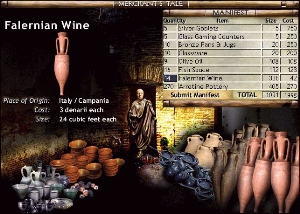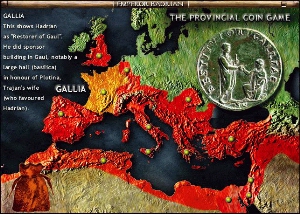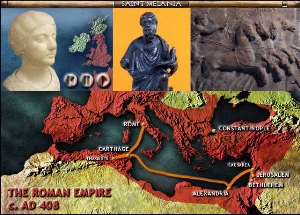
Figure 1: The Merchant's Tale: The Warehouse at Ostia with Metellus and the goods
The CD-Rom is built around four distinct journeys which, between them, cover the full span of history of the Roman Empire from the 1st century BC to the 5th century AD. They also present artefacts and sites from throughout the Roman Empire. Therefore, after using the disk, the user will have experienced a full chronological and geographical coverage of the Roman Empire. Throughout this broad structure are threaded a number of themes like trade, the army, religion and society. Although it is not a comprehensive coverage of the Roman Empire - what could be? - it does give an insight into the rich tapestry that was the Roman World.
In the first journey, The Merchant's Tale, you, the user, have to work for an elderly merchant, Antonius Metellus, in Ostia around the time of Augustus. You are loaned money to buy goods from a warehouse in Ostia which you will then sell to the Iron Age Britons. The goods themselves are mostly actual objects found in Britain, thus making the exercise more authentic. A route across the western Mediterranean, Gaul and/or Germania, the Atlantic Ocean and/or the English Channel to Britain must be chosen. On this route, you experience the hazards that faced ancient travellers, and often lose goods to storms, robbers or to damage on poor roads. Once in Britain, Metellus works out how much money you have made and comments on your performance. You can then play the game again, learn about what the Britons exported in exchange, or investigate Iron Age Britain by means of an interactive map. This game, therefore, also presents a general coverage of the Iron Age which is required at school, and an introduction to Britain's first contacts with the Roman World. The Merchant's Tale has proved to be the most popular of the four journeys, largely because it is highly interactive.

Figure 1: The Merchant's Tale: The Warehouse at Ostia with Metellus and the goods
The second journey, The Emperor Hadrian, gives the user a chance to experience the Roman Empire at its fullest extent. Firstly, you are required to help Hadrian in defending the empire. This takes you to the dark forests of the German frontier, the cold hills of Northern Britain, the hot and dusty deserts of North Africa, the exotic but treacherous Eastern frontier, and finally to revolt-torn Judaea. In each case, you have to decide whether to solve Hadrian's problems with diplomacy, warfare or a physical frontier. When you have successfully completed this exercise, you then have to match coins struck in honour of the provinces with the actual provinces themselves. Every time that you identify a coin correctly you can then explore that province in more depth, often learning more about the career and personal life of Hadrian. This game ends with a gold "consecration" coin of Hadrian and his death-bed poem. A final addition to this journey is a simplified version of Ludus Latrunculorum, the Roman strategy game.


Figure 2: The Emperor Hadrian: A screen in the Coin Game with a coin celebrating Gaul
Figure 3: Hadrian and his death-bed poem
The Story of Regina and Barates is built around two tombstones, dated to the 2nd or 3rd centuries AD, both found in Northern England at sites close to each other: South Shields and Corbridge. Interrogating the two tombstones allows the user to gain valuable information about these two people and their relationship. Regina's tombstone has a number of features (clothing, jewellery, spindle and distaff and whicker chair) which must be shaded in order to learn more about their significance. You are also required to interrogate the Latin and Palmyrene inscriptions. When these tasks have been completed, you are able to explore the regions where these two people came from: the eastern city of Palmyra in Syria, and the town of Verulamium in the territory of the Catuvellauni tribe of southern Britain. You can also learn more about Barates' possible profession and his role as a standard-bearer, and about slavery because Regina was a freedwoman. Finally, you can see an interpretation of how Barates came to Britain and married Regina. This journey is really intended to encourage users to look at evidence closely and to understand how archaeologists and historians attempt to reconstruct the past.

Figure 4: The Story of Regina and Barates: Regina's completed coloured tombstone
The final journey, Saint Melania, is set when the Roman Empire is breaking up in the late 4th and early 5th centuries AD. Through the use of maps and a collage of images, the life of this saint (known from the writings of Gerontius and various letters) can be followed. Starting in Rome just before the arrival of Alaric the Goth, and throughout the journey you are made aware of the gradual collapse of the Western Empire under the barbarian onslaught. Melania comes from a very rich senatorial family which owns estates all over the empire; however, she enthusiastically embraces the new religion, Christianity, and rejects her ancestral wealth. Her religious zeal takes her to North Africa, where she founds monasteries and gets to know St. Augustine, to the Coptic Church in Egypt where she meets hermits, and finally to Jerusalem where she patronises several major buildings. Her brief sojourn to Constantinople for an imperial wedding is the last major event in her life. This journey uses some evocative images of late Roman sites, numerous artefacts displaying the wealth of the Late Roman Empire, early Christian objects and portraits of some of the barbarian rulers. Of all the journeys, this probably covers the least known period of Roman history, and it is only really a collection like that of the British Museum that can be used to present it.

Figure 5: Saint Melania: The journey of Melania to Jersualem, narrated by her servant.
© Internet Archaeology
URL: http://intarch.ac.uk/journal/issue12/4/journeys.html
Last updated: Thu Aug 1 2002